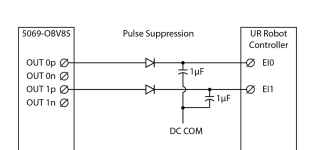Hi all,
Just a heads up on an issue that a colleague of mine was unfortunate enough to stumble upon recently.
The new 5380 Compact GuardLogix safety outputs (5069-OBV8S) have a no load detection "feature" which can't be turned off. Safe torque off is not enough of a "load" to avoid faulting the outputs on no load. So, you can't wire directly from these safety outputs to STO without something else in parallel to act as a load (the official RA "solution" is a 2.4k resistor).
I would imagine that this would also apply to the 1756-OBV8S and the new Flex 5000 safety outputs (excluding the safety relay outputs).
Enormous oversight by RA I have to say. Hopefully there'll be a firmware fix in the pipeline, but as usual, so far nobody knows anything.
If you want to see the super-detailed official response from RA:
Technote 1091239 (Access: Everyone)
Just a heads up on an issue that a colleague of mine was unfortunate enough to stumble upon recently.
The new 5380 Compact GuardLogix safety outputs (5069-OBV8S) have a no load detection "feature" which can't be turned off. Safe torque off is not enough of a "load" to avoid faulting the outputs on no load. So, you can't wire directly from these safety outputs to STO without something else in parallel to act as a load (the official RA "solution" is a 2.4k resistor).
I would imagine that this would also apply to the 1756-OBV8S and the new Flex 5000 safety outputs (excluding the safety relay outputs).
Enormous oversight by RA I have to say. Hopefully there'll be a firmware fix in the pipeline, but as usual, so far nobody knows anything.
If you want to see the super-detailed official response from RA:
Technote 1091239 (Access: Everyone)






